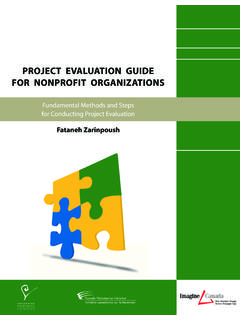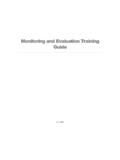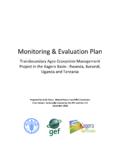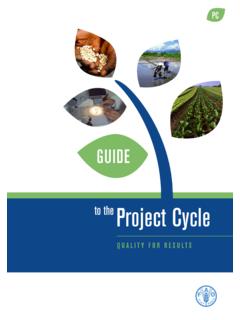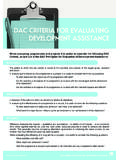Transcription of Project Plan Manual - SLO STC
1 PREPARING A Project plan . A Tutorial Self-Study guide A COMPANION TO THE INTERACTIVE TUTORIAL ACCESSIBLE FROM. MARCH 2004. 2004 by Adele Sommers Available from March 2004 Preparing a Project plan : A Self-Study guide Table of Contents Overview .. 1. Accessing the online tutorial .. 1. Intended audiences .. 1. A note about terminology .. 1. What Will the Training Cover? .. 2. Goals of the tutorial .. 2. Objectives .. 2. Prerequisites and Requirements .. 2. Prerequisites .. 2. Computing requirements for the online tutorial .. 2. Exercises and Assessments .. 3. Exercises .. 3. Assessments and extended practice .. 3. Tips on Making the Tutorial Effective .. 3. Estimated time to complete .. 3. Proceed at your own pace .. 4. Set your own learning goals .. 4. Determine your learning style .. 4. Certificate of Completion .. 5. Assess What You Already Know .. 5. Instructions .. 5. Introducing the Project plan .. 6. What is a Project plan ?.. 6. Analogy.
2 7. Limitations .. 7. How Would You Use a Project plan ? .. 7. Primary Uses of a Project plan .. 7. Extended Uses of a Project plan .. 8. Benefits of a Project plan .. 8. The Project plan Template .. 9. Purpose .. 9. Outline .. 9. 2004 by Adele Sommers Page i Preparing a Project plan : A Self-Study guide March 2004. Section Project /Program Description .. 9. Section Goals and Objectives .. 10. Section Intended Audiences or Beneficiaries .. 11. Section Products to be Created (If Any) .. 12. Section Services to be Provided .. 13. Section Methods .. 13. Section Anticipated Phases, Milestones, and Schedule .. 14. Section Potential Partners or Collaborators .. 15. Section Sources of Information and Expertise .. 16. Section Required Systems and Equipment .. 17. Section Tools, Templates, and Conventions to be Used .. 17. Section Evaluation Processes .. 18. Section Review and Approval Processes .. 19. Section Method for Managing Changes and Derivatives.
3 19. Section Project Responsibilities and Dependencies .. 19. Section Risks to be Managed .. 20. Section Open Issues and Questions .. 21. Section Appendices and Attachments .. 22. Examples of the Project plan in Action .. 23. Project plan Case Studies .. 23. Story 1: The Flora and Fauna Visitors Association .. 23. Story 2: The Ergomizer User's Manual .. 25. Story 3: Midnight Publishing .. 26. Apply the Tools to Your Situation .. 27. Summary .. 28. Assess What You've Learned .. 28. Instructions .. 29. Resources .. 30. Glossary .. 30. Course Evaluation .. 31. Page ii 2004 by Adele Sommers PREPARING A Project plan . A Tutorial Self-Study guide Overview Preparing a Project plan explains how to create a plan of action for a program or Project . In the sequence of activities that follows, you'll discover the benefits and practical applications of using a Project plan to help you chart your venture. In the early stages, your plan will undoubtedly include placehold- ers that will evolve over time.
4 You'll explore tools and templates that can help you start and expand your plan as information becomes known. Upon completion of this self-paced tutorial, you will be able to use these tools to prepare a Project plan to describe the vision of your completed Project or ongoing program. We hope you enjoy Preparing a Project plan ! We welcome your feedback and suggestions on any aspect of this tutorial. Accessing the The online tutorial is a Web-based training module that covers the online tutorial same material presented in this self-study guide , and also includes interactive components and exercises. To access it, go to Also refer to the Prerequisites and Requirements on page 2. Intended This tutorial is designed for broad participation, but focuses pri- audiences marily on the Project or program planning needs of people who: Develop products or services (such as technical professionals), and/or Work with programs or projects that serve community needs (such as nonprofit organizations).
5 A note about The terms Project and program appear interchangeably herein;. terminology however, a few distinctions may be in order. The term Project often refers to an effort with a more distinct life cycle and time table, such as the design and development of a product. The term program often refers to an ongoing effort, such as a service provided by a nonprofit organization. In either case, a Project plan can help define the directions that a Project or program may take. 2004 by Adele Sommers Page 1. Preparing a Project plan : A Self-Study guide March 2004. What Will the Training Cover? Goals of the This module: tutorial Defines a Project plan and explains its benefits and uses. Introduces and explains each section of the Project plan template. Follows a case study example to convey various aspects of using the template. Presents three short stories that illustrate different outcomes for projects that used a Project plan to varying degrees.
6 Provides ways to apply your knowledge through assessments and exercises. For example, you have the option of preparing a plan of your own to earn a Certificate of Completion (see page 5). Objectives After completing this material, you will be able to: Identify several valid uses for a Project plan . Explain how the use of a Project plan can benefit particular indi- viduals or groups. Identify ways in which a Project plan aided or could have helped the outcomes of hypothetical projects. Practice preparing plans for your own projects using a template and examples you can download in Apply the Tools to Your Situation (see page 27). Prerequisites and Requirements Use the following guidelines to help make your learning experience more effective. Prerequisites To help you relate more effectively to the training material, some kind of experience working with a Project is desirable. When taking the tutorial online, you should be familiar with your Web browser and with downloading, editing, and e-mailing files.
7 Computing Recommended configurations and components appear below; you may requirements be successful with other variations. The online tutorial uses Flash, so for the online your browser will require the Flash plug-in. tutorial Pentium-compatible machine (133 MHz or faster) running Windows XP/2000/ME/NT/98, OR a Macintosh running OS or later 32 megabytes (MB) of available RAM. Super VGA display, 800 x 600 or greater resolution 10 MB of disk space Page 2 2004 by Adele Sommers March 2004 Preparing a Project plan : A Self-Study guide Internet browser and access Microsoft Word (for editing the Project plan template). Exercises and Assessments This tutorial contains activities that will enable you to practice and apply what you are learning, as well as evaluate how well you are learning it in a self-paced mode. Exercises Interactive exercises enable you reflect on what you are learning and apply it in practical ways. The exercise scores are not recorded; how- ever, you are encouraged to complete the exercises to reinforce your understanding and skill development.
8 Assessments How will you know if you learned something, and can apply it in a real and extended context? Here are some ways to find out. practice Assess What You Already Know. You will have the opportunity to measure your knowledge before going through the tutorial by tak- ing the preliminary assessment. This assessment is a short set of questions about the material and is not designed to be intimidat- ing. If it turns out that you already know the material, you can probably skip the tutorial! Assess What You've Learned. After completing the tutorial, you'll have an opportunity to see how your knowledge has increased by taking the final assessment. Apply the Tools to Your Situation. To help you transfer your new skills to an actual Project , you can practice with templates and examples. These tools have been designed for you to adapt to your own needs. You can tailor the Project plan template available from the tools page to create your own Project plan , either real or hypothetical.
9 By submitting a Project plan after completing the tutorial, you can receive a Certificate of Completion (page 5). Tips on Making the Tutorial Effective Here are a few tips to help you make the most of your learning expe- rience. By proceeding at your own pace, setting your own goals, and accommodating your own learning style, you can take responsibility for the quality of your learning. Estimated time The tutorial should take only a few hours to complete. You may want to complete to spend extra time working on a Project plan of your own, for which you can earn a Certificate of Completion (page 5). 2004 by Adele Sommers Page 3. Preparing a Project plan : A Self-Study guide March 2004. Proceed at Self-paced training offers the opportunity to learn new subjects within your own pace your schedule. To make the best use of the material, we suggest that you devote a certain amount of time each week to this process. Set your own Identify what is important to you in this learning experience.
10 Training learning goals objectives list some of key goals the tutorial intends to accomplish. In addition to the training objectives, try to make your activities real by doing the following: Reflect on the information by relating it to your current or past experiences. Assimilate the information, such as by keeping a notebook of use- ful ideas. Apply information from the tutorial by completing the exercises and by using the tools at the end to help guide your own projects. Accommodate your own learning style, as explained below. Determine your You may strongly prefer one or more particular methods of absorbing learning style information, such as those listed below. Try to concentrate your efforts in your preferred areas. Visual-textual learning. You prefer reading information in textual form, such as in paragraphs and tables. Visual-diagrammatic learning. You absorb information most easily when it appears in images, diagrams, and tables. If information is not presented to you diagrammatically, try summarizing the infor- mation in these forms.


